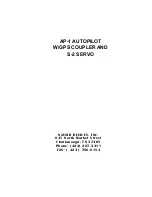
- 4 -
INSTALLATION OF SERVO ACTUATOR - S2
CRANK ARM
The S-2 crank arm servo is easier to install than the capstan version and is suitable for all
but the largest homebuilt aircraft with heavy aileron loading. Because most installations
use the crank arm servo, information specific to the capstan servo is found in Appendix
A.
The S-2 crank arm servo uses a pushrod terminated by rod end bearings to link the servo
arm to the aircraft's aileron control system. We try to identify the type of rod end bearing
the customer needs for his intended installation and include it with his order. If it turns
out that your pushrod is not long enough (it must be trimmed to the correct length), or the
size of your rod end bearing is incorrect, please contact Navaid for parts exchange.
CONFIGURING THE CRANKARM
In your installation it may be more convenient to rotate the crank arm to a new
orientation that will give a neutral at +/- 90 degrees or 180 degrees from that as supplied
by Navaid. The servo crank arm is secured to a flange by four machine screws that can be
removed for indexing the crank arm +/- 90 degrees.
If you wish to rotate the crank arm 180 degrees, it is easier to just remove one of the stops
that limit crank arm rotation, rotate the crank, and replace the stop. It will be necessary to
change the indexing of the feedback pot after this, see RESETTING SERVO NULL
POINT, page 8.
In most cases the servo is installed with the bottom of the servo parallel to the ground, but
it operates equally well upside down or sideways
There are four holes in the crank arm that give operating radii with the combinations of
force and peak-to-peak travel listed in Table 1 below:
Crank Arm Max. Travel Force
Radius (peak-to-peak) (@ 30 in-lb)
1.0 in. 1.5 in. 30 Ib.
1.2 in. 1.8 in. 25 Ib.
1.4 in. 2.1 in. 21 Ib.
1.6 in. 2.4 in. 19 Ib.
Table 1
Choose the shortest operating radius on the servo crank arm that allows full aileron
movement (aileron stop to aileron stop) without driving the servo crank arm into its limits
(+/- 50 degrees).
Summary of Contents for AP-1
Page 2: ......
Page 9: ...7 WIRING DIAGRAM FOR HAND HELD GPS AND AP 1 WITH GPS COUPLER WIRING DIAGRAM Fig 3...
Page 27: ...A 3...





















